How To Repair Concrete Slab Wall
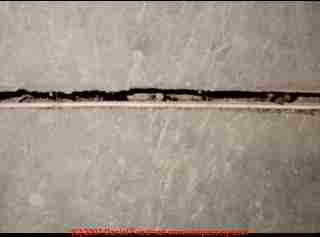 How to Seal or Repair Cracks in Concrete Floors & Walls
How to Seal or Repair Cracks in Concrete Floors & Walls
- Mail service a QUESTION or Annotate nigh sealing flooring or foundation or wall cracks, water entry through cracks, crack sealing approaches, costs, reliability
InspectAPedia tolerates no conflicts of interest. Nosotros accept no relationship with advertisers, products, or services discussed at this website.
How to seal cracks in concrete floors, foundations, walls, or other masonry: this article how to seal and repair of cracks in poured concrete slabs, floors, or walls.
We list all of the current methods used to seal control joints or cracks that occur in those building surfaces, giving the properties, general procedure, and pros and cons of each method: control joint inserts, masonry caulks, radon fissure sealants, semi rigid epoxy resin crevice fillers, special poly urea caulks designed equally a joint filler - polyurethane cream injection to seal cracks, grouts including portland cement, latex-modified, epoxy, modified epoxy-supported, and furan grouts or other products used to fill or seal cracks in concrete or other masonry surfaces & structures.
We besides provide an ARTICLE Index for this topic, or you can try the page peak or bottom SEARCH BOX as a quick way to observe information you need.
How to seal control joint & expansion joint cracks in concrete slabs
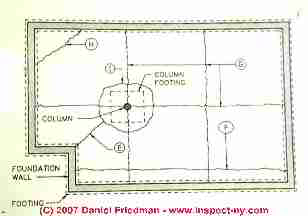 Here we hash out how to choose among and utilize the alternative methods for repairing or sealing cracks in masonry surfaces such as poured physical floor slabs, physical foundation walls, or brick or masonry block foundation walls. Nosotros describe use of epoxy sealants, polyurethane foam sealants, and hydraulic cement crack repair sealants.
Here we hash out how to choose among and utilize the alternative methods for repairing or sealing cracks in masonry surfaces such as poured physical floor slabs, physical foundation walls, or brick or masonry block foundation walls. Nosotros describe use of epoxy sealants, polyurethane foam sealants, and hydraulic cement crack repair sealants.
This article serial describes how to recognize and diagnose various types of foundation failure or damage, such as foundation cracks, masonry foundation crevice patterns, and moving, leaning, bulging, or bowing building foundation walls.
Types of foundation cracks, cleft patterns, differences in the pregnant of cracks in different foundation materials, site conditions, building history, and other evidence of edifice movement and harm are described to assist in recognizing foundation defects and to help the inspector split cosmetic or depression-take a chance weather condition from those likely to exist important and potentially plush to repair.
Here we discuss: a list of materials used to make full poured physical slab control joints. How to seal a croaky masonry foundation wall or floor slab.Typical concrete crack grooming for sealant with an epoxy product.
Employ of Polyurea as a control articulation filler or cleft sealant in concrete slabs (Polyurethane Foam Injection Method). Employ of Epoxy-supported Grouts as a control articulation or fissure filler in concrete slabs or walls.
List of the Types of Tile Grouts, their Bonding Agents and other Properties. Concrete expansion joint sealant products, epoxies, caulks.
Employ of Hydraulic Cement for Repairs in Physical Slabs, Foundations, or Masonry Block/Brick Walls.
When should we not seal a foundation wall or floor slab cleft?
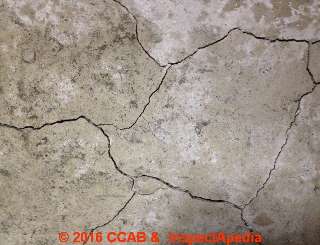 Alert: some crack sealing operations may make cleft diagnosis or monitoring more than difficult
Alert: some crack sealing operations may make cleft diagnosis or monitoring more than difficult
Scout out: First of all exercise not just seal a crack if the crack size, shape, design, location, or other evidence point that something important is going on with the foundation. Farther evaluation and choice of proper repair method may be in order.
If for example we think that there may exist active foundation movement or settlement going on and if that status is going to exist monitored for evidence of further movement, merely pushing a flexible sealant or caulk into a crack is leaves some worries unattended:
This photograph of foundation cracks attributed to physical that included atomic number 26 sulfide (pyrrhotite), provided courtesy of CCACB - Connecticut Coalition Against Crumbling Basements. The blueprint looks similar shrinkage just the crack width is larger than normal shrinkage keen.
Watch out: earlier sealing physical cracks like those at page top exist sure that y'all've got a credible diagnosis of their cause. This great design could be due to fe sulfide pyrrhotite cracking damage from inclusions in the original concrete equally mixed and placed.
See FOUNDATION DAMAGE by MATERIAL or INCLUSIONS for details.
- Concete Cleft Sealant hides ongoing movement: Using a flexible sealant in a structural crack may make it difficult to see modest amounts of future motion since the sealant may stretch and tolerate small increases in crack width.
This can increase the difficulty of crack monitoring and diagnosis
- Sealant doesn't fix a structural problem: Using a sealant in a foundation or floor slab fissure may fail to address the underlying cause of the problem such every bit foundation settlement or frost heaving which need to exist addressed
- Simply some epoxy sealants are in fact too a repair: Some structural epoxies may seal and as well "repair" the damage in a structural sense.
For instance Sika produces epoxy resin & structural engineering science systems for concrete scissure repair using a structural injection system. http://usa.sika.com/
We may decide to seal a cracked wall or floor slab anyway, to try to reduce water entry in a building, but recall the implications of sealing we've just listed.
Types of Sealant Repairs in Concrete & Concrete Structures
Control joint sealant:
command joints, designed to command where cracks announced in concrete placed horizontally or vertically, are themselves are sealed confronting water, frost, debris and to handle recurrent movement (listed below) using a flexible sealant.
Recurrent movement:
Seal and repair cracks in physical using injection of either epoxy resin or polyurethane where recurrent motility is expected (in my opinion a flexible sealant is what's chosen for hither) when the movement is considered normal, maybe caused by traffic vibration or temperature swings, and where the movement is non threatening structural impairment.
Stop a water leak:
Seal and repair cracks in concrete when it is important to quickly stop water leaking through a scissure,seal those cracks in concrete using injection of either epoxy resin or polyurethane sealant.
Structural repair:
Seal and repair structural cracks: for some situations (commonly where an engineer, adept in masonry repair has made an assessment), actual structural repairs are fabricated using injectable epoxy resin and perchance in some (probably low-load) cases by using injectable polyurethane sealant.
In my opinion (I'm not a P.East.) this application of injected epoxy resin is probably most-appropriate when cracks take appeared due to non-recurrent stresses. When we epoxy cracked structural concrete or a concrete slab that was broken by an initial installation error or by a subsequent upshot, we look the repaired expanse to be as strong or stronger than if no cleft were present.
Structural reinforcement:
some sealant manufacturers such as Sika provide seal or wrap-and-seal systems that actually provide additional strength to existing concrete structures such as concrete columns.
Structural reinforcing wrap systems may include employ of synethetic fabrics, carbon fibre fabrics, and other wraps. These products might also be used on steel or concrete that has been damaged by weather, frost, corrosion.
Surface repair:
for working surfaces such equally industrial piece of work floors or parking decks cracked past spider-webbed shrinkage cracks that are not-structural, special "healer-sealer" crevice sealants may be applied.
Specialty Epoxy Resin and Structural Engineering Systems for Physical
The situations listed above are those of most-involvement to owners of residential and smaller commercial buildings. Below are examples of boosted applications of epoxy resins and sealants in construction:
Anchoring epoxy products:
used to inject into holes into which connectors such equally bolts or postal service anchors will be placed.
Bonding agent epoxies: used to promote secure bonding between abutting, oft dissimilar materials. A special case is the use of segmental bridge adhesives that bond post-tension pre-bandage concrete bridge segments to other structural members or to one another.
Epoxy resin adhesives are formulated for bonding concrete to concrete, concrete to other masonry, concrete to steel, and concrete to wood or to other substances.
Overlay expoxy resin coatings:
used as a blanket on physical surfaces for skid protection or for patching damaged surface areas. Some of these epoxy resin products are formulated for use equally a high-friction surface or for use to repair spalled or chipped concrete surfaces.
Special acknowledgement: some of this give-and-take was informed by reviewing products and engineering literature provided by
- Sika Corporation, 201 Polito Artery, Lyndhurst, NJ 07071 USA, Tel: ane-800-933-SIKA Website: http://usa.sika.com/. Sika produces a broad range of agglutinative, bonding, reinforcing and sealing products including automotive adhesives, building envelope adhesives, concrete admixtures, flooring and floor covering adhesives, repair & protection products, rofoing products, sealants, adhesives, waterproofing agents.
How to seal a cracked masonry foundation wall or floor slab
To seal a shrinkage crack or a command joint crack in a poured physical slab, regardless of whether or not information technology has occurred at an expansion or control joint, it may be appropriate to seal the surface to resist h2o entry and radon gas entry.
Command joints are also sealed to provide a smooth and clean concrete surface which does not collect surface moisture or debris. Keeping surface water from entering at a control joint might in some cases also assistance avoid uneven soil settlement below the slab and tipped or heaved slab sections.
To seal a command joint or expansion joint crack in a physical slab use a flexible sealant designed for foundation crack repair or sealing. The radon mitigation manufacture offers special foundation caulks and sealants for that purpose as well. (If water is coming up through a concrete floor or slab, sealing cracks is probably non going to be plenty - you demand to address the cause of water below the floor.)
List of Types of Materials Used to Fill or Seal Poured Concrete Slab Control Joints

- Pre-made control joint strips of plastic or other cloth
- Masonry caulks or flexible (typically polyurethane based) radon sealant caulks.
Pproduct sources are listed at SEAL CRACKS By POLYURETHANE Foam INJECTION - live link only beneath.
- Semi rigid epoxy resin fissure fillers (discussed in this article).
Epoxy products intended for concrete expansion joints.
These products are described and their sources listed below in our give-and-take of this method that includes injection ports and (usually) two-office epoxy resins injected into the crack.
- Special poly urea caulks designed every bit a joint filler - polyurethane foam injection to seal cracks. This method is discussed below.
Separately nosotros discuss this method in particular along with product sources
at SEAL CRACKS by POLYURETHANE FOAM INJECTION
- Hydraulic cements for concrete or other masonry flooring, foundation, or wall repairs of cracks & leaks
Whatever sealant that is going to be used to fill a control joint in a slab needs to have the power to bail to the sides of the cut or opening of the articulation, to remain flexible over temperature and moisture changes, and to withstand both pinch and expansion every bit the concrete moves in response to curing and in response to temperature and moisture changes.
Epoxy, for example, is non generally used to fill the expansion joint in newly-poured concrete because the concrete is just as well wet and has as well much movement for the epoxy to bond and perform passably. Similarly, a special product would be needed to make full a control articulation in concrete in very common cold atmospheric condition.
Watch out: select the correct product for your application. Some crack fillers like the spray injection product Good-Bye Cracks elastic scissure "embrace" product shown in our photograph are not suitable for concrete.
The manufacturer says this product can be used to make full cracks in plaster, drywall, and wood and that it dries to a flexible, paintable finish.
Typical concrete fissure training for sealant with an epoxy product
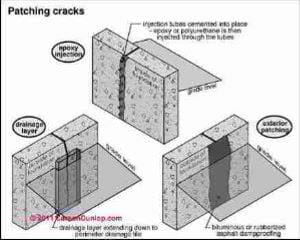 Carson Dunlop Assembly' sketch shows three mutual methods used to seal cracks in masonry walls in an effort to stop foundation leaks.
Carson Dunlop Assembly' sketch shows three mutual methods used to seal cracks in masonry walls in an effort to stop foundation leaks.
[Click to enlarge any image]
- Cleaning a physical crack for patching and sealing:
The fissure or expansion joint must be cleaned of all droppings; power washing and vacuuming may piece of work but inspect the crack or articulation to exist sure it is make clean along its entire length.
Otherwise the sealant may fail to adhere and the crack will leak. Wire-brushing or chipping the crack sides is not normally required when using an epoxy sealant.
(Traditional concrete or masonry patching (and plaster repairs), on the other manus, was traditionally applied after cracks were chipped and widened into an inverted "vee" shape to help keep the patch cloth in the crack.)
- Mix the epoxy sealant
co-ordinate to the manufacturer'due south directions.
Some low volume epoxy sealants are supplied in a dispenser which mixes the ii parts together in the proper ratio automatically during dispensing from a tube (meet your dentist for an example.) Other crack sealants such equally prepared caulks, may come pre-mixed in a tube.
- Install the backer rod
specified by the sealer manufacturer if you lot are sealing an expansion articulation.
The capitalist rod provides a flexible filler that keeps the sealant in the joint during curing and also reduces the total book of concrete crack sealer epoxy needed.
Nosotros recommend using backer rods also if sealing broad cracks in concrete walls or floors, simply first you need to take those cracks evaluated to make up one's mind the cause as other important structural repairs could exist needed first.
- Sand
(clean, dry) may exist used as a filler for cracks - an easier approach if you are repairing an irregular crevice in a flooring. Sand should cease about 3/four" from the superlative of the flooring surface to requite acceptable volume of sealer epoxy in the scissure.
- Epoxy crack patch cure time:
Continue traffic off of the sealed fissure until the sealant has cured.
Typically a thin film volition grade on a crack filler epoxy in eight hours, the sealant will be hard enough to withstand traffic in 24 hours, and it will fully cure in about a week.
These notes are based on epoxy product awarding data available from Lone Star Epoxies.
Use of Polyurea as a command joint filler or crack sealant in physical slabs (Polyurethane Foam Injection Method)
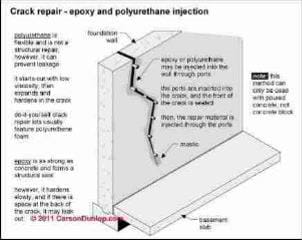
Polyurea joint filler products for concrete control joints have received attention for filling physical control joints and is increasingly used in that application since this cloth is resistant to moisture, has loftier adhesion backdrop when used with concrete, and will cure in very cold weather.
Polyurea sealant products are also reported to be useful in sealing command joints in "green" physical which has non yet had its full 28 day period of initial curing.
An advantage of polyurea or polyurethane used as a crack sealant is that the flexibility of the material will suit slight seasonal or temperature-related movement that might otherwise cause new cracks in an epoxy-repaired structure or reopening of repaired cracks in a mortar or concrete-repaired crack.
Also in our experience, because the injected polyurethane foam expands after it is injected into a crevice, you may find it easier to fill the crack through the edifice floor slab or wall than when using alternative repair methods such as epoxy or masonry repair kits.
Carson Dunlop Associates' sketch (left) illustrates foundation wall crack repair using epoxy or polyurethane injection.
List of materials, product sources, how-to for polyurethane cream scissure sealant
- See our split up article POLYURETHANE Foam INJECTION Crack REPAIRS for details of the process for using polyurethane foam to seal foundation cracks and for a list of sources & brands of polyurea or polyurethane foam sealants, caulks, and crack repair kits. .
Utilise of Epoxy-supported Grouts equally a command joint or crack filler in concrete slabs or walls
Epoxy grouts are available which can be mixed and troweled into a concrete scissure or joint. These products are less flexible than the control joint fillers described above. In our opinion, an epoxy grout filler may work fine to provide a well-bonded repair to a stable wall or flooring crack in an area where there is no predictable further movement such as from temperature or moisture variations.
Watch out: while epoxy, a material stronger than concrete lonely, is sometimes used for structural repairs, if your building masonry (physical, brick, masonry block) is dandy due to ongoing motility, settlement, frost, or other active or recurrent problems, unless those atmospheric condition are fixed, sealing a crack with epoxy will not prevent new cracks from forming.
But read the manufacturer's intended application earlier buying an epoxy reinforced grout for edifice crack repair. Exercise not use the product where it was non intended unless a call to the manufacturer provides you with good information that information technology'south acceptable to do so.
On the ane hand we similar using a rigid material to fix a supposedly stable fissure in a residential building since the fact that the patch is inelastic means it will be easy to see if there is ongoing or new building motion.
On the other paw, a modest amount of moment in a foundation wall or flooring slab due to changes in temperature volition leave a flexible crack filler un-damaged and sealed where a rigid material may neglect.
List & Sources of Epoxy Grout Products & Structural Injection Physical Repair Products
- Elasta Gel 6170 Epoxy® flexible epoxy and expansion joint sealant, two component, no VOC, flexible epoxy resin which is rated for use on parking decks and, according to the manufacturer, Solitary Star Epoxies, tin also exist used to repair concrete spalling on such surfaces.
- Emecole Structural Repair Epoxy products, 50 East. Montrose Dr., Romeoville IL 60446, United states Tel: 800-844-2713, Website: www.emecole.com
- Emecole 121 Premium - Fast Curing Scissure Repair Epoxy
- Emecole 101 Original Formula - Crack Repair Epoxy
- Emecole twoscore - Concrete Deck Repair Epoxy
- Emecole cargon fiber reinforcement products: used by professional repair contractors where a building wall suffers big cracks or bowing. (Likewise see Bulged foundation Repairs.)
Quoting: Emecole Epoxies are recommended for structural cracks. Unlike polyurethane foams, epoxies will not expand. However, they cure to an incredibly hard solid, making them ideal for structural repairs. Our two-component epoxies are strong, durable and reliable. After curing, Emecole Epoxies create a more powerful bail than concrete, resulting in an extremely strong repair.
- Epoxy grouts (ANSI 118.three 1988) for tile applications (watch out for proper tile surface cleaning within the cure fourth dimension; cleanup is done using h2o)
- Laticrete™ epoxy grouts
- Mar-Flex Epoxy Injection Concrete Crack Repair Kit, Tel: 800-498-1411, Website: www.mar-flex.com
Quoting: Depression-pressure injection and repair of approximately 8-10 lineal feet. Contains the following; (1 jar 8oz.) Mar-flex Crack Seal (one jar 8oz.) Port Adhesive (ii) Wooden Sticks (12) Surface Ports and Caps (2 Cartridges) Mar-flex Injection Polyurethane/Epoxy Resin 1:ane (2) 3/eight" :24 Mixing Nozzles (i) Injection Hose Associates with plastic shut-off valve (2 pair) Latex Gloves (1) Plastic Trowel (1) Wire Castor (1) Drop Cloth (one) Complete Instructional DVD. The company also offers low-viscosity crack filler that tin be injected into both dry and damp cracks and a "Seal & Peel" crack repair kit.
- Polygem Epoxy pastes, resins, & grouts, POLYGEM, Inc. P.O. Box 609 Due west Chicago, IL 60186, Tel: 888-446-3987, Website: world wide web.polygem.com
- Polyject #1001 LV for hairline to 1/16" cracks
- Polyject #1001MV for 1/16" to 1/8" cracks
- Polyject #1001 HV for one/8" to 1/4#148; cracks
- Polyject #1001 EHV for over one/four#148; cracks
Quoting: Polygem, Inc. articles epoxies, vinyl-esters and silicones for various industries and markets such equally: Structure, Waterproofing, Mining, Industrial, Electrical, Zoological, Golf and DIY. Polygem, Inc. has been custom formulating epoxies in excess of xx-five years and has created over ane,500 unique formulations.
- Ramset™ Epoxy Grout - a pourable epoxy resin, likewise tin can be mixed with sand and applied with trowel.
- Shor D 65-eighty®
- Sika Corporation, 201 Polito Avenue, Lyndhurst, NJ 07071 USA, Tel: 1-800-933-SIKA Website: http://usa.sika.com/. Sika produces a wide range of adhesive, bonding, reinforcing and sealing products including automotive adhesives, building envelope adhesives, concrete admixtures, flooring and floor covering adhesives, repair & protection products, rofoing products, sealants, adhesives, waterproofing agents.
- Other semi-rigid, epoxy products - contact us to add together products & information - no fees involved
Use of Peel-and Stick Surface Sealant Kits for Epoxy-Repair Cracks in Concrete Walls
For building surfaces that will remain exposed and where cosmetic appearance is a concern, RadonSeal (and possibly others) offers a stick-on injection port system that allows the crack cloth to be injected into a wall or flooring crack to leave a smooth surface fifty-fifty with the existing wall or floor surfaces on either side of the crack.
RadonSeal'south Easy-Peel Sealer kit uses a surface seal that includes injection ports. Subsequently the injected sealant has cured, the surface seal and injection ports are peeled abroad from the repaired surface.
Quoting: RadonSeal Scissure Seal and Port Agglutinative 1:i is a loftier modulus epoxy gel designed for surface sealing of cracks prior to injection and for attaching surface ports. Information technology can also be used for bonding miscellaneous materials to concrete.As with any epoxy adhesive, surface preparation is critical.
Concrete surfaces should be cleaned by wire brushing or other mechanical means. All loose or unsound material must be removed. Surfaces should be dry and dust gratuitous to insure a superior bond. Application onto wet surfaces is non recommended.
- RadonSeal Scissure Seal & Port Adhesive, Novion, Inc., xviii L'Hermitage Dr., Shelton CT 06484, Tel: 800-472-0603, Website: www.radonseal.com
- Mar-Flex Epoxy Injection Concrete Scissure Repair Kit, Tel: 800-498-1411, Website: www.mar-flex.com
The visitor offers low-viscosity creack filler that tin be injected into both dry out and damp cracks and a "Seal & Peel" crack repair kit.
How to Choose Between Using an Epoxy Cleft Sealant & a Polyurethane Crack Sealant
High Pressure or Low Pressure Slab or Foundation Wall Crevice Sealant Injection
Most foundation wall and floor slab cracks tin exist successfully filled and sealed using low-pressure injection such as that afforded by a caulking gun and cartridge of sealant, or like device for both epoxy and polyurethane foam sealants.
Professional person polyurethane foam injection crack sealing applicators may use a high-pressure injection organisation using equipment that includes a pump or a device similar to an automotive grease gun and pressures upward to 250 psi. Drilling to prepare injection ports along the crack may be required.
Reasons to apply an epoxy-based crack repair or sealant method
- Structural repairs are needed. Epoxy, properly mixed and installed, is stronger than the concrete to which it is bonding. But as we warn in a higher place, unless y'all correct the cause of ongoing (such as settlement or earth loading) or cyclical (such equally water or frost) structural motility & cracking, new cracks will develop in the construction
- Very fine cracks need to exist sealed - and so fine that it may be hard to inject a polyurethane foam, but still possible to inject a low-viscosity epoxy sealant. For wider cracks utilize a higher viscosity epoxy preparation or consider a polyurethane injection approach.
- May provide a smoother surface for finished surfaces such equally a finished basement (but seal & peel systems tin can besides accommodate this need)
Reasons to employ a polyurethane cream injection crack sealant
- Structural repairs are not needed but sealing a crack against air or water leaks is required
- If you lot wait small-scale amounts of recurrent or cyclical building motion that might re-scissure or leak where a rigid fissure sealant is practical, using a flexible polyurethane sealant may evidence more durable
- If the crack is large an expanding polyurethane cream sealant may be easier to install and is also probable to be less expensive per linear foot of crack.
- If the scissure extends through the foundation wall and is large, an epoxy sealant may only leak out of the other side of the wall or floor slab - the cream injection approach may also crusade foam to extrude through the structure but is more than likely to also successfully fill the crack.
- If the fissure is actively leaking an epoxy injection sealant is more than likely to fail to bail properly to the masonry surfaces and a polyurethane sealant volition perform more reliably. (Polyurethane sealants are moisture activated.)
- Do-it-yourself repairs: homeowners may find this approach easier than the epoxy approach
Employ of Hydraulic Cement for Repairs in Physical Slabs, Foundations, or Masonry Block/Brick Walls
Hydraulic cement used for crack repairs is a waterproof cement product that is sold dry out and mixed with water on the job to ready a slurry that is painted (or troweled) over a crack in a foundation wall or in some cases (DryLok or UGL foundation wall sealants) painted over the wall surface in a paint mixture.
Hydraulic cement is oft lower in price than the epoxy and polyurethane products described hither. Yet, the repair is at risk of re-cracking due to production shrinkage or due to even slight movements in the structure from settlement, earth or frost pressures, or thermal changes.
A primary advantage of hydraulic cement for repairing & sealing cracks in masonry floors or walls is that information technology can handle and finer seal a crack even when at that place is significant active water leakage through the fissure. The cement, properly mixed (every bit stiff equally possible) cures and expands to seal the scissure in the presence of h2o.
[Every bit early every bit 1969 we used this approach to successfully seal holes in a masonry block foundation wall through which groundwater was squirting several feet into the basement. We mixed a plug of hydraulic cement and forced information technology into and against each pigsty until it set firmly plenty to remain in identify - about 3 minutes. - Ed.]
Watch out: any cement product is caustic and can cause skin burns or center or lung damage if you lot do non handle it properly and wear the proper protective gear for eyes, lungs, skin.
For an effective repair of a wall or flooring cleft using hydraulic cement you volition demand to clean out and widen the crack to approximately ane" wide x 1-i/2" deep, ideally with the crack wider at its innermost and more narrow at the wall or floor surface (a "Five" shape) to requite a mechanical bond to the cured concrete patch.
For a wall crack through which h2o is seeping, seal the crack progressively beginning at its highest bespeak on the building wall. When all of the crack has been sealed except a unmarried pressure relief signal, that final leak is sealed with a molded plug of cement.
Listing of the Types of Tile Grouts, their Bonding Agents and other Properties
- Hydraulic cement
- Portland cement grout (ANSI 108.10 1985)
- Latex-modified portland cement grouts (we've used these with good success indoors in tile floors for better water resistance)
- Epoxy grouts (described above) normally with a water-dissolved mix
- Modified Epoxy grouts (ANSI 118.8 1988.) combining portland cement and epoxy (some sources say the chemical resistance is like to direct Portland cement only the consequence is a harder grout - just what chemicals are resisted may vary among products)
- Furan resin grouts use furfuryl booze in their products - no water is used. These are highly acid-resistant, as well hard to install.
Questions and answers about sealing floor cracks in Slabs
Question: should we seal flooring cracks exposed when we pulled upwardly basement carpeting? Our house had a radon problem
We take had our home mitigated for radon. The latest reading is 2.9. Therefore, we feel we are controlling the radon successfully. We are in the process of removing rug from a 8' 10 12" bathroom in the basement. In preparation for installing an overlay linoleum nosotros found a irregular crack in the physical floor.
Our question is - should we seal this cleft with some time of sealer that could exist painted on and would this exist effective? If so, what blazon of product would y'all recommend? - F.H.
Respond: In general, sealing exposed floor slab cracks is a good idea where in that location was a radon business concern, though if your mitigation system is working it might not exist critical.
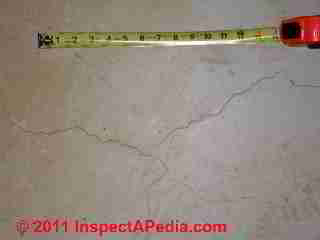
A competent onsite inspection by an expert might detect other cracks, openings, or sources for radon gas leakage that yous'd want to address, but usually that would have been done when your radon mitigation system was installed.
Following the installation of a radon mitigation system the installer is expected to make a follow-up radon gas level measurement to be certain that the mitigation is working as expected, and s/he also inspects the home to see if you take exhaust fans or other features that could accidentally interfere with proper performance of the radon mitigation system itself.
If all of that was washed, the added radon gas leakage into your home from pulling up carpet to expose a floor cleft should not be significant.
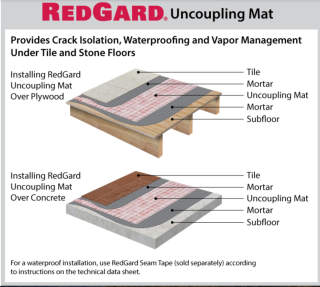 Still it would exist good practice to seal any flooring slab cracks that you betrayal.
Still it would exist good practice to seal any flooring slab cracks that you betrayal.
Here are some things to consider:
If your floor slab cracks are hairline (less than 1/8" across - encounter our photograph above left) they may be normal physical shrinkage and they may be too fine to seal with a polyurethane sealant (see our polyurethane sealant link below).
In that instance a sealant paint or a combination of mesh record and sealant used to cover cracks in concrete earlier installing tile would still work well.
Particularly where ceramic tile is to exist installed on a slab we want to protect against telegraphing of slab cracks upwardly through (and breaking) the tile.
Run into details at TILE ISOLATION MEMBRANES where we talk over Custom Building Products' RedGuard Uncoupling Mat & Uncoupling Crack Isolation Seam Tape and membranes (shown above) and other Concrete Slab Crack Suppression and Isolation Joint Record products.
and also see FLOOR TILE INSTALL on CONCRETE.
For larger floor slab cracks (such as shown in our photo below) at that place are some sealants ("caulks") widely used past radon mitigators that work well in flooring or wall cracks, typically polyurethanes. The crack is vacuumed or cleaned, and when dry out, sealed.
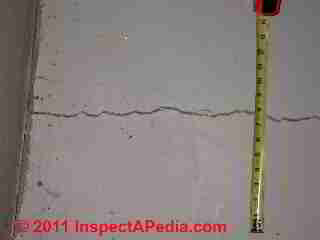
More sophisticated floor slab crack sealing is done if you lot are going to put down ceramic tile: the repair includes a strengthening mesh glued to the floor over the crack to resist the transmission of the cleft upwards through the ceramic tiles. Under carpet you don't need that step.
At CONCRETE SLAB Cleft REPAIR
and SEAL CRACKS by POLYURETHANE FOAM INJECTION at nosotros discuss methods to seal cracks in floors.
At HOW to REMOVE INDOOR RADON we include more than details on how to get the radon level downward in homes. Yous'll come across that sealing and caulking to stop radon gas from entering at floor or wall cracks or joints is of import.
While you're at it, don't forget to bank check for gaps that may have opened betwixt the floor slab and the foundation wall - seal those besides.
Reader Q&A - also come across the FAQs series linked-to below
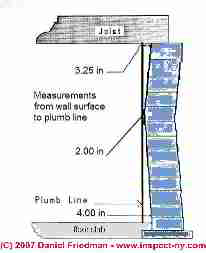 Joseph
Joseph
While normally I trust the opinion of a licensed professional person engineer every bit authoritative, there are some concerns here.
A sealant or epoxy is obviously appealing as information technology is far less troublesome and plush than foundation repairs that require insertion of structural steel reinforcement, pilasters, or even re-building of a wall.
Only such a repair is more-probable to be appropriate when the amount of cracking is minor and where at that place is no significant inward bulge of a wall.
Your comment is posted on our article on using sealants and repair epoxies on a CONCRETE foundation wall or floor slab.
Sealing a crack that'southward leaking through a wall or floor is probable to be a very unlike problem than repairing a structural foundation wall that is damaged, moving, displaced.
Without answering at least a few basic questions we cannot assess the suitability of a foundation repair proposal.
What are the nature of, extent (not just scissure length but width, displacement, etc), and cause of your foundation harm?
- What is the effect of the foundation impairment on the structure?
- If a wall is sufficiently cracked and bulged, an experienced inspector or foundation repair person may have the stance that without either reinforcement or reconstruction in that location is risk of a costly, even unsafe sudden foundation plummet.
At a national conference I hosted on this topic nosotros polled a room full of over 100 engineers and home inspectors and foundation repair contractors.
The predominant opinon was that more than than an inch of inwards bulge or lean or displacement in a physical block foundation wall was considered serious and in need of more than a ring-aid or superficial repair.
Your engineer may have already considered everything and she may operate with a style that prefers to "simply give the client the answer" rather than explaining anything at all. We frequently run into this among credentialed experts such as engineers, architects, and doctors.
But when the patient or customer is uncertain, nervous, or hearing alien communication, some willingness to explicate, in patently language, is needed.
ane. is your engineer actually expert and personally experienced in residential foundation harm cause, failure, and repair?
Often a P.E. may be ethical, savvy, smart, simply may accept expertise in a different surface area from the i in which you lot've got comments. An engineer isn't supposed to practice engineering out of their expanse of education and certification, but I've certainly seen exceptions.
(A well-known engineer in Long Island NY was trained equally an aerospace engineer who later decided to open a home inspection company. He admitted privately that at inception he knew nix near residntial construction.)
While there are some structural expoxies used in some concrete damage repairs, they are not, in my experience, applied to a residential cake foundation wall with horizontal groovy, bulging, buckling. Case questions (this is not the full list):
- How much breadth and depth were in your engineer's study? Were you lot given comments almost
- the cause of the horizontal corking,
- what steps to accept exterior the building to stop that ongoing cause,
- the history of the damage: its age, duration
- the extent of motility: how buckled inwards is the wall, where is the point of most-in motion?
- how did the expert determine that the wall should be repaired rather than reinforced or re-built?
Actually? The upward-side of trying a repair epoxy is that it'due south cheap, quick, and ***IF*** there is non already substantial foundation movement then you might live with a "lookout and see" attitude for a few years.
Sentry out: a 20 pes crack in a foundation wall joined by a six-foot crack in an abutting wall sounds every bit if there may be an underlying crusade of settlement or foundation movement. Some diagnosis of the cause, the effect on the structure, and the extent of movement are needed to support the choice of foundation repair action.
Your engineer and your foundation repair companies may have considered this but I don't hear it in your question.
2. What about the foundation repair company?I tend to trust the opinion of a foundation repair company who has inspected, repaired, or otherwise rebuilt a very large number of buckled or bulged block wall foundations.
- Are all of the foundation repair companies y'all contacted in agreement?
- What are the years of experience, number of repair jobs, repair successes, failures, of the foundation repair visitor>
- Is the company specifically experienced in your foundation type, mateiral, construction?
- Are you lot concerned (or is your engineer) that the repair companies are behest what is non just most-safe for themselves simply also well-nigh-profitable?
See OTHER PEOPLE'due south MONEY for a clarification of this possible problem.
But ALL of what I'm saying is arm-waving speculation as I don't know much your specific foundation.
You might want to take a await
at FOUNDATION Damage SEVERITY
and
BULGE or LEAN MEASUREMENTS
I accept a engineer,south written report stating my horizontal basement wall crack is not structual and requirers Sika epoxy 3001 injection.I have had several companies come in and they all say I need steel.
The crack is about 20 anxiety on one wall and 6 feet on the attached wall. the walls are poured concrete. Nosotros have had the engineer over twice and same result even when I asked him if i needed steel
Evan Oakes said:
Thanks for the tips on how to seal/repair cracks in concrete floors & walls. On my side hither I used hartfordepoxyflooring com epoxy physical repair on my cracks on floors,
Once y'all epoxy patch has cured properly according to instructions, clean the floor over again to remove any dirt and oil, then buff the flooring with an 80-dust sanding screen. Vacuum and wipe the floor to remove whatever dust and apply the epoxy pigment. This must cure for 12 to 24 hours, so you lot tin can apply a clear epoxy finish. Thanks for your tips.
I appreciate yous posting nearly this. Only the other twenty-four hour period, a bad storm came rolling through my neighborhood, and it turned out that I leaked into my basement walls. Considering of this, my whole basement got flooded.
I similar that part where you talked virtually repairing the impairment especially. This is something that I needed to larn nearly. And then cheers so much for all of this!
Sealing a surface fissure against water entry does indeed reduce the chances of frost impairment in Illinois or other freezing climates.
Take a look at Physical SHRINKAGE CRACKS for help convincing yourself that this is simply that and not slab settlement.
I have a covered patio west/ a 14.5 x 10.5 ft concrete slab that is effectually iv inches thick. There are two posts supporting the roof over the patio, on the SE and SW corners of the slab. This past spring I noticed a thin crack extending from the patio door to the slab border by the backyard.
The crack is in the approx middle of the slab (91" from due east side of slab, 83" from west side). The crevice is now a little wider than when I first noticed it, but is probably less than 1/64 of an inch.
As all-time I tin can tell, the crack extends two inches into the slab. I'grand considering applying a physical sealant to continue h2o out of the crack as winter approaches (I live in southern Illinois), in hopes of slowing the spread of the crack. Is this appropriate? Thanks.
Re-posting from private email:
Hi our car park which is beneath sea level the cracks leak at high tide if we put force per unit area relief valve in and let information technology run all the time will it stop the leaking thanks rob
Moderator answer:
Robert
I'm unclear how a force per unit area relief valve would have anything to do with the seawater entry into a beneath-sea-level car park but perhaps we are not thinking of the same component.
A combination of sub-slab waterproofing (perhaps pumping bentonite clay), sealing cracks (foundations are not normally built to be absolutely waterproof), and possibly a pumping arrangement (sump pump to draw water from below the slab and belch it to a suitable location) would work if the pump is sufficiently powerful (or multiple pumps and sump pits) to reduce the water pressure below the slab.
Photos of the building from exterior showing elevations and proximity to ocean and body of water leval, and also of the leaky car park from inside would be helpful.
Anon:
Pressure level where and how?
The best way to terminate leaks through physical is to find and redirect the source of h2o under or outside the foundation walls or floor;
Other suggestions in a more complete guide are at https://inspectapedia.com/Wet_Basements/Basement_Waterproofing_Sealer.php BASEMENT WATERPROOFING
will pressure level valve stop concrete floor leaks
...
Continue reading at SHRINKAGE CRACK REPAIR or select a topic from the closely-related articles below, or see the consummate ARTICLE Alphabetize.
Or see SEAL CRACKS in Physical, HOW TO FAQs - questions and answers posted originally on this page
Or see these
Physical Fissure Diagnosis & Repair Articles
- Physical COLD Cascade JOINTS
- Physical DECK PIER Process
- Physical DIY Modest Chore PROCEDURE
- Physical DELIVERY & MIXING
- Concrete FOUNDATION, WALL, SLAB DEFECTS
- Concrete REINFORCEMENT, Cobweb
- CONCRETE SHRINKAGE CRACKS
- CONCRETE SLAB Crack EVALUATION
- Physical SLAB CRACK REPAIR
- CONTROL Articulation CRACKS in Physical
- Fissure REPAIR STANDARDS for FLOORS
- POLYURETHANE Foam INJECTION CRACK REPAIRS
- SEAL Concrete CRACKS, HOW TO
- SHRINKAGE CRACK REPAIR
- SLAB Cleft REPAIR STANDARDS
- VERTICAL FOUNDATION Motility REPAIR
- FLOOR TILE INSTALL on CONCRETE
- FOUNDATION DAMAGE by Material or INCLUSIONS
- FOUNDATION Harm & REPAIR GUIDE - dwelling house
- FOUNDATION Harm SEVERITY
Suggested citation for this web page
SEAL CRACKS in CONCRETE, HOW TO at InspectApedia.com - online encyclopedia of building & environmental inspection, testing, diagnosis, repair, & problem prevention communication.
Or see this
Index to RELATED ARTICLES: ARTICLE Alphabetize to BUILDING STRUCTURES
Or use the SEARCH BOX found beneath to Ask a Question or Search InspectApedia
...
Ask a Question or Search InspectApedia
Try the search box just below, or if you prefer, postal service a question or comment in the Comments box below and we will respond promptly.
Search the InspectApedia website
Notation: appearance of your Comment beneath may be delayed: if your comment contains an prototype, spider web link, or text that looks to the software equally if it might be a web link, your posting will appear later it has been approved by a moderator. Apologies for the delay.
Technical Reviewers & References
Click to Prove or Hide Citations & References
Publisher InspectApedia.com - Daniel Friedman
How To Repair Concrete Slab Wall,
Source: https://inspectapedia.com/structure/Concrete_Crack_Repairs_Sealants.php
Posted by: woodymatimprod.blogspot.com


0 Response to "How To Repair Concrete Slab Wall"
Post a Comment